The Checker Maven
The World's Most Widely Read Checkers and Draughts Publication
Bob Newell, Editor-in-Chief
Published each Saturday morning in Honolulu, Hawai`i
Contests in Progress:
Bailey's Blackjack
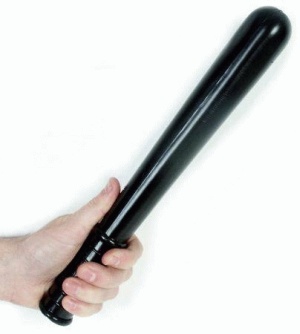
Willie Ryan never fails to please, and this month's installment from his classic Tricks Traps & Shots of the Checkerboard is no exception. While the pyrotechnics shown in today's position are not forced, they are by far the most spectacular way to wrap up a win, and the instructional value of Mr. Ryan's analysis is, as always, unmatchable.
Here's Willie once again:
"Ranking high among the classical bombshells of the board is this 11-piece sweep, credited to the late N. A. Bailey, of Rutland, Vermont. Although Bailey's blitz has been published many times, it has never been shown with the proper sequence of moves. As a result, the reader misses the scientific meaning of the preliminary moves leading up to the shot. Proceed with:
| 9-13 | 28-24 | 16-19 |
| 22-18 | 12-16---A | 23-16 |
| 10-15 | 24-19*---B | 12-19 |
| 18-14 | 8-12 | 30-26*---D |
| 15-18 | 19-15*---B | 2-6---2 |
| 24-20 | 4-8 | forming the |
| 6-9 | 26-22*---C | diagram. |
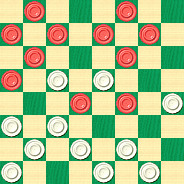
WHITE
White to Play and Win
W:W32,31,29,27,26,25,22,21,20,15,14:B19,18,13,11,9,8,7,6,5,3,1.
A---A losing move that can be tamed only by forcing black into the Bailey shot. The play from here to the finish is a first-class example of the indispensability of stroke technique in cracking a formational "dud" that otherwise would be drawable. The correct play to draw at A is: 1-6, 32-28, 6-10, 24-19, 10-17, 21-14, 11-16*, 20-11, 7-16, 19-15, 8-11, 15-8, 4-11, 28-24, 16-20, 14-10, 12-16, 23-14, 9-18, 25-22, 18-25, 29-22, 11-15, 26-23, 2-7, 30-26, 7-14, 22-18, 15-22, 26-10, 3-8, 10-7, 13-17, 7-3, 8-12, 3-7, 17-22, 7-10, 5-9,10-6, 9-14, 6-10, 14-17,10-14, 17-21,14-17, 22-25, 17-22, 25-30, 31-26, 16-19, 24-15, 12-16. Hugh McKean.
B---A meticulous probing of the position will prove that these moves are absolutely necessary to hold the win.
C---The correct and only move to win! Even Bailey, the author of this fine win, as well as others, prescribed 15-10 here, which allows black to get away by 16-19!---1
D---Stops 1-6 because of 14-10, and 19-24 because of 32-28."
1---This actually appears to allow Black to win! Computer analysis gives this possible line of play: 15-10 16-19 23x16 12x19 26-22 19-24 22x15 11x18 30-26 24-28 20-16 8-12 27-24 12x19 24x15 18-23 26x19 9x18 19-16 7x14 Black Wins--Ed.
2---1-6 holds out longer here but still loses; one line is 14-10 7x14 22-17 13x22 26x1 9-13 15-10 11-15 20-16 8-12 16-11 12-16 1-6 2x9 11-7 3-8 10-6 8-12 6-2 16-20 2-6 19-23 25-22 18x25 29x22 23-26 6-10 15-19 10-15 19-24 32-28 26-30 28x19 White Wins--Ed.
Can you find the flashy finish? When you've solved it, click on Read More for Willie's solution.![]()
Boxology
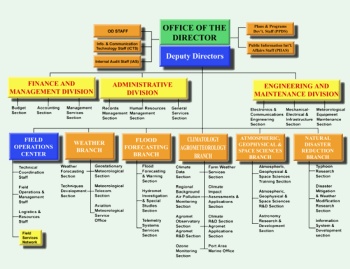
Fortunately, today we won't be discussing what is often known as "boxology" or the drawing of incredibly boring corporate organizational charts. But the term did come to mind when we looked at the "boxy" appearance of the pieces in today's edition of Checker School. The position is diagrammed below.

WHITE
White to Play and Draw
W:WK2,19,20:B11,12,K27.
Boxy, yes; boring, certainly not! Although the two White men seem quite boxed in, there is a clever draw in the offing, one that is easier to spot than usual for a Checker School problem.
Can you find the draw, or will you be relegated to the bottom of the pecking order? We certainly hope that won't be your fate, and in fact clicking on Read More will leap you at once to the top of the charts.![]()
Uncle Ben's Porch: Back To School

When we last visited with Tommy on Uncle Ben's Porch, he was getting ready for the Varsity Checker Team tryouts, and even though he was quite young, was hopeful of winning a Varsity berth. Now, the new school year has started, and the tryouts were over. We rejoin Tommy on the first Saturday morning after the opening of school.

A very sad Tommy was sitting on Uncle Ben's porch this Saturday morning. "I didn't make it, Uncle Ben," he said in an almost despairing voice. "I didn't make the Varsity Checker Team. I got all the way through the tryouts and I was all set to make the final cut. Then Coach Hovmiller tested us on problems ... and ... and ..."
Tommy just couldn't continue.
"Let me guess, Tommy," said Uncle Ben in a kindly manner. You were able to solve the first few, but then you missed one that the coach thought a Varsity candidate should have solved."
Tommy was silent for a moment and then blurted out, "But I got the rest of them right! It isn't fair!"
"Fair, Tommy?" answered Uncle Ben. "How can it be unfair? All the students at the tryout had the same opportunity to solve the problem that you did."
"Only two boys and one girl got it right," said Tommy, "and they're a year older and...."
"And they got the Varsity slots," concluded Uncle Ben. "As is right and fair. But let's not cry over spilt milk! Next year you'll be a year older yourself, and you'll almost certainly make the Varsity. Meanwhile, this year, do your best on Junior Varsity. No doubt you'll be the top player and get selected Captain! But show me the problem that troubled you."
Tommy arranged the pieces on the board. "It's Black to win," he stated, "and I looked at it for a while and had an idea."
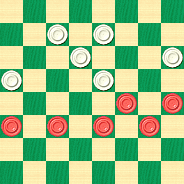
BLACK
Black to Play and Win
B:B6,9,11,12,14:W18,20,23,27,31.
"I thought 12-16 was the winning move, Uncle Ben, but then Coach Hovmiller played 27-24. I played 13-17 to prevent 26-22, meaning to follow-up with 10-15."
"Yes, Tommy," replied Uncle Ben, "but what was wrong with that idea?"
"Well, Coach Hovmiller played 24-19, squeezing my man on 16, and then I saw that 10-15 was impossible now! So I failed, Uncle Ben... I failed!" Tommy concluded, practically on the verge of tears.

Uncle Ben knew it was time to pour the lemonade. He waited while Tommy took a few comforting sips, and then said, "You didn't fail, Tommy, you just made a simple mistake while under pressure. Players both average and great have done that. And if you are honest with yourself, you'll know it means you need another year of play to really be ready for Varsity on a team as good as the one that plays for your school."
"Yes, sir, I know that," admitted Tommy at last, "but I do hope you aren't disappointed with me, and will still keep me on as your student."
"Oh, Tommy," cried Uncle Ben, "never fear! You are a talented youngster and I'm proud to have you as my student. Now, let's have another look at that position, and let's have you master it once and for all!"
Was that the trace of a smile starting to appear on Tommy's face? "You bet, Uncle Ben!" he said with genuine enthusiasm, and the two of them, the young student and the old master, bent over the board to study in earnest.
Would you have passed Coach Hovmiller's final test? Try out the problem for yourself, and then click on Read More for the solution, a sample game, and numerous additional examples of the same theme.![]()
The Paisley Pickle Barrel

With this entry in our very popular Tricks Traps & Shots of the Checkerboard reprint series, we're in a bit of a pickle ourselves, as the unthinkable has happened: from our computer analysis of the position presented by checker legend Willie Ryan, we've found that Mr. Ryan seems to have made a most untypical error. So our "pickle" is this: do we publish the correction, or simply give Mr. Ryan's position and analysis as originally published?
In the end, we decided to print the new analysis, as we're certain that Mr. Ryan would have always preferred to see the best moves brought forward.
So, first we'll listen to Willie explain the situation. Then, we'll see his analysis followed by what the computer has to say.
"On my road travels around the country, I am frequently asked, 'Mr. Ryan, with what particular play do you win most frequently in your exhibitions?' There is no doubt that my No. 1 haymaker is a nondescript concoction, which I have tabbed the Paisley Pickle Barrel, because I have pickled more plebes with it than you can shake a stick at. This is it: 11-16, 24-19, 8-11, 22-18, 10-14, 25-22, 16-20, 29-25---A and we reach the fateful fix shown on the diagram.
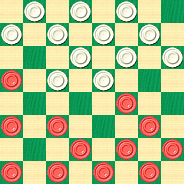
BLACK
Black to Play and Win(?)
B:W18,19,21,22,23,25,26,27,28,30,31,32:B1,2,3,4,5,6,7,9,11,12,14,20.
A---Natural, but probably a loss. 22-17 results in a draw, and so does 19-15, 4-8, 22-17, etc."
What do you make of this particular pickle? Think it over --- it's anything but easy --- and then click on Read More for some deep and fascinating insights.![]()
A Small Problem

In the winter scene depicted above, it seems that the owner of the car has "a small problem" to deal with. And, while the solution to such a problem is straightforward, the amount of effort involved looks to be considerable.
Checker problems, though, follow different definitions. "Small" checker problems generally deal with relatively few pieces; in today's offering, drawn from our Checker School series, there are but three pieces per side. The solution to "small" checker problems is not always, or even often, straightforward; and the amount of effort needed to find the solution is at times substantial.
Here's the situation we ask you to consider.
Black
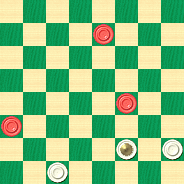
White
White to Play and Win
W:WK27,28,30:B7,19,21.
White is certainly better off, but is it enough to win? That's your little problem! Dig your way out and then click on Read More to see the solution, notes, and a sample game.![]()
The Steel Stroke

One thing Willie Ryan could do as well as any checkerist who ever lived was to tell an entertaining story. Here, in our monthly installment from his classic Tricks Traps & Shots of the Checkerboard, Willie relates a couple of anecdotes about a checker position that dates back over 200 years but still astounds us today.
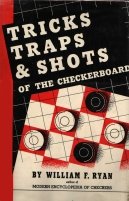
'Now we come to an old chestnut credited to James Steel, of Newcastle, England, identified as the Steel Stroke. When Joshua Sturges reached the diagrammed position below in his "Guide to Draughts" (1800), he overlooked the stroke, playing 17-21 to a draw instead! After the 1905 American-British International Checker Match, former World's Champion Robert Stewart, of Scotland, was persuaded by friends to play "Ajeeb," the automaton checker player, then on exhibit at the old Eden Musee in New York City.
When the position shown below was reached, Stewart moved 12-16 to start the shot. When the "figure" failed to respond, the attendant told Stewart he would have to move faster. Whereupon, Stewart informed the attendant it was Ajeeb's move. The attendant then pretended to wind up the figure, announcing that the game could not be finished because the main steel spring in the machine was out of order!
| 11-15 | 21-14 | 28-24 |
| 23-19 | 15-18 | 11-16 |
| 8-11 | 19-15 | 26-23 |
| 22-17 | 4- 8 | 16-20 |
| 9-13 | 24-19 | 31-26---B. |
| 17-14 | 13-17---A | See the |
| 10-17 | diagram. |
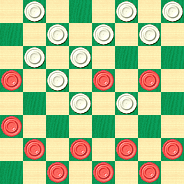
BLACK
Black to Play and Win
B:W32,30,29,27,26,25,24,23,19,15,14:B20,18,17,12,8,7,6,5,3,2,1.
A---White has a trap here, for if black moves 11-16, white will win with 26-22, 16-23, 15-10, 6-15, 25-21, 18-25, 27-4.
B---Right after Ajeeb made this move, he developed mechanical cramps. The proper play to draw is: 15-10, 6-15, 19-10, 17-22*, 25-21, 12-16*, 32-28, 16-19, 24-15, 22-25, 29-22, 18-25, 21-17, 7-11*, 30-21, 11-18, 23-19, 18-22*, 19-16, 2-7, 17-13, 22-25, 13-9, 25-30, 9-6, 5-9*, 14-5, 7-14, 27-24---1, 20-27, 31-24, 1-10, 5-1, 14-18*, 1-6, 10-14, 6-10, 18-22*, 10-26, 30-23, and black can draw with care---2. This fine play is by World Champion Walter Hellman.'
1---The King's Row computer program chooses 6-2 instead and finds what looks like an easier draw than Hellman's line with the calculated line of play being 6-2 30-25 27-23 25-22 23-19 14-18 16-12 8-11 19-15 11-16 28-24 20-27 31-24 16-19 24-20 19-24 20-16 18-23 16-11 23-26 15-10 26-31 2-6 and it's clearly a draw---Ed.
2---King's Row agrees that this position is a draw despite Black being a man down---Ed.
No need for you to have cramps or a broken spring over this one; unwind the tension by clicking on Read More to see the solution.![]()
Similar But Not Quite The Same
Can you find a total of eight differences in the two pictures above? It's a classic sort of puzzle, and unless you're rather skilled with images, finding the last little variation is often quite a challenge.
In today's edition of Checker School, we present two "similar but not quite the same" positions. The optical differences are a little easier to find than in our teaser above, but the over-the-board solutions may prove somewhat more resistant.
In both of today's positions, shown below, White is to play and win. We'll give you a small tip: one of the positions is quite a bit easier than the other, despite similar appearances. Not much of a tip, we agree, but we are known to be notably stingy in the hint department.
| B. OLDMAN | A. SCHAEFER |
| BLACK | BLACK |
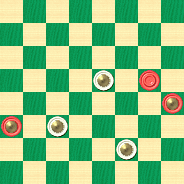 | 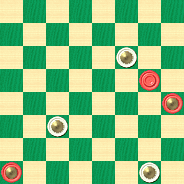 |
| WHITE | WHITE |
| White to Play and Win | White to Play and Win |
| W:WK15,K22,K27:B16,K20,K21. | W:WK11,K22,K32:B16,K20,K29. |
Make a difference and find the solutions; but if you can't tell the difference, it will make no difference if you click on Read More to see the answers along with a sample game and detailed commentary. And, for extra non-checker related credit, identify the U.S. destination known as "The City Different."![]()
A Study In Structure

In this month's excerpt from Willie Ryan's unmatchable Tricks Traps & Shots of the Checkerboard, we see a situation that Willie characterizes as "not so impressive as most of the other items." Of course, Willie has extremely high standards, but we can certainly say that we're impressed with this little gem! Add in the fact that it is of practical use, and you have something that certainly ought to command our attention. Here's Willie to explain it all to us.

"The following stroke theme is not so impressive as most of the other items in my compendium, but it is one of major importance, and of a type most likely to be overlooked in crossboard play. The game itself was adapted from one I played with 15-year-old Leonard Rosenfield, of Boston, who has all the promise of a future World Champion.
| 9-13 | 15-18 | 6-15 |
| 24-20 | 28-24 | 32-28 |
| 6- 9 | 11-15 | 12-16---A |
| 22-18 | 26-23 | 30-26 |
| 10-15 | 8-11 | 16-19---C, |
| 18-14 | 23-19 | forming the |
| 9-18 | 2- 6 | diagram. |
| 23-14 | 19-10 |
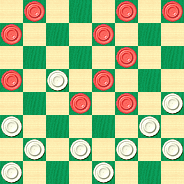
WHITE
White to Play and Win
W:W14,20,21,24,25,26,27,28,29,31:B1,3,4,5,7,11,13,15,18,19.
A---If 4-8 is moved, follow with 30-26* (not 24-19,15-24, 28-19, 11-15, 19-10, 18-22, 25-18, 5-9, shot), 12-16---B, 26-23, 8-12, 25-22*, 18-25, 29-22, 16-19, 23-16, 12-19, 22-18* (not 31-26, 1-6, 14-10, 7-14, 27-23, 14-18*, 23-14, 6-9, 14-10, 9-14, etc., black wins), 15-22, 24-8, 3-12, 27-24, 1-6, 20-16, 12-19, 24-15, 22-25, 28-24, 25-30, 24-19, 30-25, 31-27*, 25-22, 27-24, etc., ending in a draw. Leonard Rosenfield vs. Wm. F. Ryan.
B---18-22, 25-18, 15-22, 26-17, 13-22, 27-23, 11-15, 23-18, 8-11, 24-19, 15-24, 28-19, 1-6, 19-15, 22-26, 31-22, 7-10, 14-7, 3-19, 29-25, etc., accomplishes a draw. Wm. F. Ryan.
C---Down the wrong alley! The correct thrust is 4-8, 26-23, 8-12, making the draw play shown in Note A."
Can you structure a solution, or is your thinking perhaps too rigid? Clicking on Read More is a predictable part of our weekly structure, and you know that it will bring you straight to the solution, and an interesting computer addition to Willie's original analysis.![]()
Small, Square, Two Inches of Ivory

The famous British novelist of the late 18th and early 19th century, Jane Austen, spoke of her writer's canvas as a "small, square, two inches of ivory." By this she seemed to have meant that her works were limited in scope and in some sense "miniatures" based on the society in which she lived.
But this is a checker column, not a literary review, and we bring up Miss Austen only as a point of comparison to miniatures in checkers. They too deliberately limit their scope, but, like Jane Austen's famed novels, have no lack of intricacy, depth, and ultimately, charm.
Today we publish a Checker School study taken from the pages of Ben Boland's Famous Positions in the Game of Checkers. It's indeed a small square of ivory with much appeal and value. Here's the position.
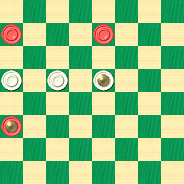
WHITE
White to Play and Draw
W:W13,14,K15:B5,7,K21.
Can you find the White draw in this deceptively simple setting? You needn't be a Victorian gentleman or lady to find the answer; pure skill at checkers is what's required. When you've arrived at your solution, click Read More for the correct procedure accompanied not by harpischord or pianoforte, but instead a trio of sample games and extensive explanatory notes.![]()
Uncle Ben's Porch: Tommy's Tryout

It was getting near the end of the school year. Tommy had done well and had kept up his grades, and so Mom had allowed him to continue to spend a couple of hours every Saturday morning over on Uncle Ben's porch, learning checker lore from the old retired gentleman, who had won much-justified fame and recognition in an earlier year as a checker author, teacher, and master player.

"Well, Tommy," Uncle Ben said as they had settled into their chairs on another hot and steamy Florida morning, "pretty soon there will be the Elementary School Varsity Checker Team tryouts."
"Yes, Uncle Ben," Tommy replied, "I'm eligible for the team next year, and the tryouts take place just before the end of this year." (Of course, Uncle Ben wasn't really Tommy's uncle, but everyone called him that.) "I'm going to do my best to make the team," Tommy added.
"Well, Tommy, you've been coming right along," Uncle Ben said, "but of course your school has one of the top teams and it's going to be tough competition to win a team spot." Uncle Ben paused and reflected for a moment. "Now I know you're probably the best player in your class, but it's quite rare for someone to make Varsity the very first year that they're eligible. So it just might happen that you would have to play Junior Varsity for a season or two."
Tommy knew that Uncle Ben was trying, in his own kind and gentle way, to tell him not to be disappointed if he didn't make the team on his first try. Tommy understood just how hard that might be. But didn't Uncle Ben know just how badly Tommy wanted to make the team? After all, he'd been working on his checkers really hard this past year, paying close attention to everything that Uncle Ben taught him each Saturday morning. And besides, he'd made a point of keeping up his grades, skipping all of his favorite weeknight television programs in order to have enough time to do really good schoolwork.
Uncle Ben winked at Tommy, He did that often, but it still always caught Tommy by surprise. Uncle Ben always seemed to know just when to lighten the mood, offer a glass of his delicious homemade lemonade, or just the right word of encouragement. He really was a special kind of grownup.
"Oh yes, Tommy, I do know what you're thinking, and you have indeed turned into a fine young checkerist. But some things just take time. The wood in these fine old chairs we're sitting on didn't get seasoned over night. Some things just take time and waiting and patience. That's often hard for a young fellow to understand, but you'll see it all in time. So do your best, and whether you make the Varsity team now or a little later, I'll still be very proud of you and all that you've learned."

Before you could know it, the lemonade glasses were filled to the brim, and Uncle Ben had turned to the checkerboard, which as usual was set up with the day's work. "So, Tommy, I've got one for you here," Uncle Ben said. "It's something that will come up often in your games and who knows, you might even see it in your tryouts. Take a look."

Well, Tommy thought, Uncle Ben is hardly ever wrong--- he couldn't remember a single time, in fact, that Uncle Ben hadn't taught just the right thing at just the right time. Tommy sipped the cool, refreshing lemonade while he looked over the position Uncle Ben had laid out.
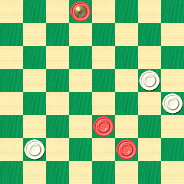
BLACK
Black to Play and Win
B:W17,13,8:BK31,10,6.
As usual, it didn't look easy at all, but Tommy knew that Uncle Ben was always giving him something that would stretch and grow his skills while still staying within his grasp... if he would just work at it hard enough. This time, Tommy was through most of his glass of lemonade before the idea came to him, and as he always did, said, "Hey Uncle Ben, how about this...." and started to move the pieces.
Can you solve the position? Whether or not you played Varsity Checkers for your school, give it a try and then click on Read More for the solution, a sample game, and no less than twenty additional examples of this theme.![]()
The Checker Maven is produced at editorial offices in Honolulu, Hawai`i, as a completely non-commercial public service from which no profit is obtained or sought. Original material is Copyright © 2004-2024 Avi Gobbler Publishing. Other material is the property of the respective owners. Information presented on this site is offered as-is, at no cost, and bears no express or implied warranty as to accuracy or usability. You agree that you use such information entirely at your own risk. No liabilities of any kind under any legal theory whatsoever are accepted. The Checker Maven is dedicated to the memory of Mr. Bob Newell, Sr.


